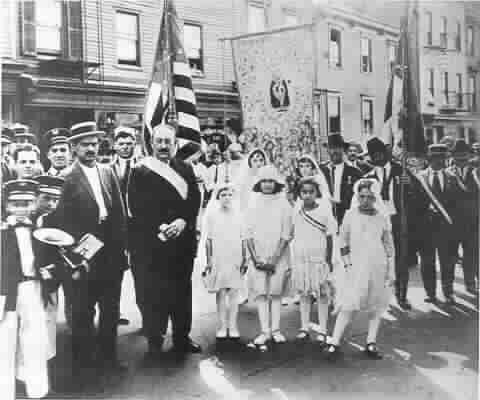| Life
in Brooklyn: Neighborhoods |
||
| Home Immigration Life in Brooklyn Assimilation Research
|
Gowanus
Societa Di Giovanni Battista at annual parade on President St between Third and Nevis in 1922. The building to the left is 502 President St.. 494 President is on the far right of the photo. History The town of Gowanus was established in 1639 by the Dutch on a small tidal creek leading out into a small bay. In 1700, one of the first settlers, Nicholas Vechte, built a farmhouse of brick and stone on the site which later became Washington Park. Near this park the Battle of Brooklyn was fought in August 1776. Gowanus Bay as it became known, became one of the manufacturing centers of Brooklyn including shipbuilding and gas storage. The stream was dug by railroad owner Edwin C. Litchfield to become the Gowanus canal. It was lined with light manufacturing operations and ringed with gritty neighborhoods. The Gowanus was extremely foul smelling due to the heavy pollution. Like many owners of the Gowanus factories, Mr. Litchfield lived at the crest of the hill in Park Slope during the 1800s. The Gowanus Canal neighborhood is at the bottom of the hill from Park Slope. Like the Carroll Gardens neighborhood across the canal, Gowanus was a neighborhood with a large Italian population. Houses The houses (and businesses) along the canal were largely made of wood. On the block 400 block of President St., the breakdown of 49 lots is, 3 were empty, 13 were brick buildings and 33 were wood. In contrast, in a similar poor and industrial neighborhood near the water in Manhattan where the Blumettis lived at the same time, all but one building on the block was brick. Relatives of my grandfather, the Pomaricos, owned the home at 494 President through a mortgage. Another Pomarico relative lived at 552 President, one block uphill. Both households were used as references and sponsors for subsequent waves of Pomaricos coming into Brooklyn from Italy. Businesses Businesses lining the Canal in 1910 (or one block off)
Brooklyn Dodgers In 1883, the Brooklyn Dodgers were started as a minor league team playing out of a stadium in Gowanus located at Third Street and Fourth Avenue in Washington Park. First used as a clubhouse, in 1896 Nicholas Vetche’s house was demolished. The team joined the American Association and were first called the Brooklyns, then the Trolley Dodgers and finally the Dodgers. They moved to Ebbett’s Field at Bedford and Montgomery Ave. in 1913. Sources Brooklyn City Directories 1900-1933 New York Census 1905, 1915, 1925 New York Census Enumeration District Map 1915 U.S. Census 1900, 1910, 1920 Snyder-Grenier, Ellen M. Brooklyn! An Illustrated History Philadelphia:Temple University Press, 1996. Willensky, Elliot. When Brooklyn was the World. New York: Harmony Books,1986. |
![]()
